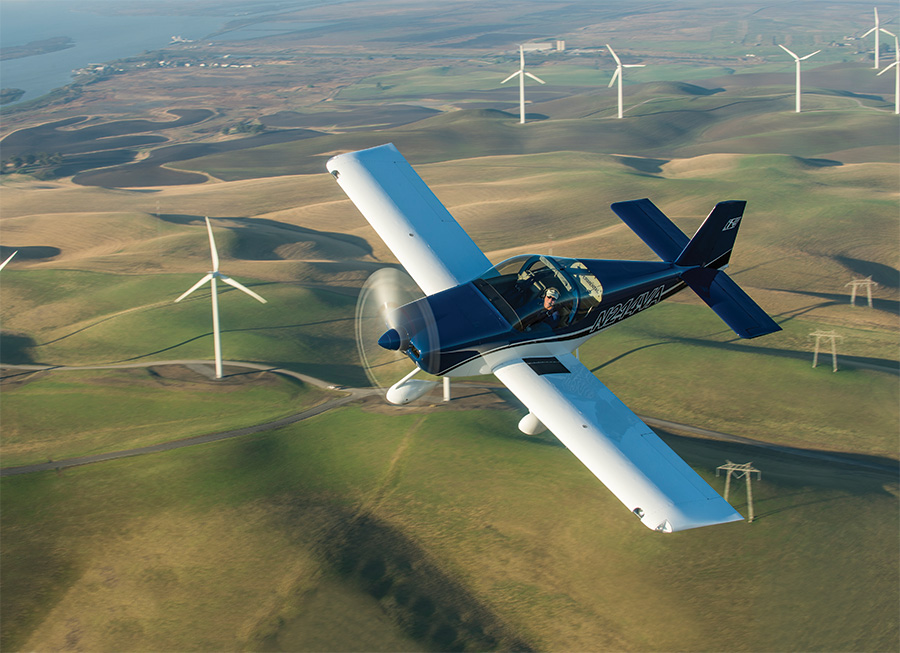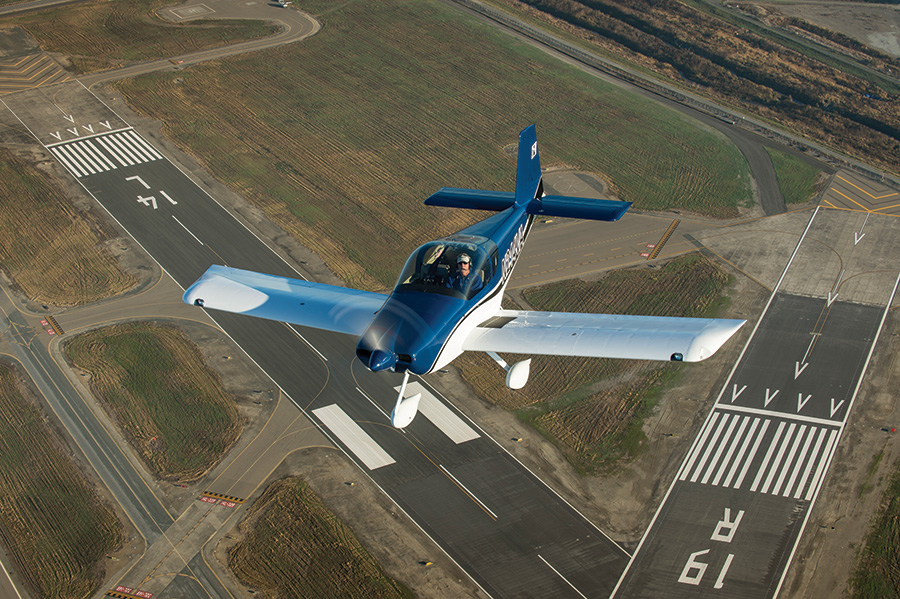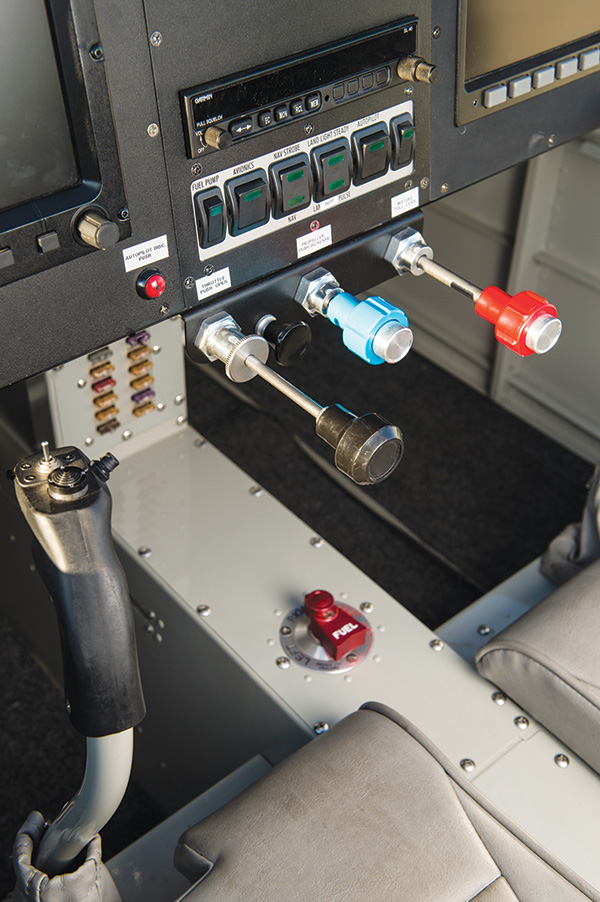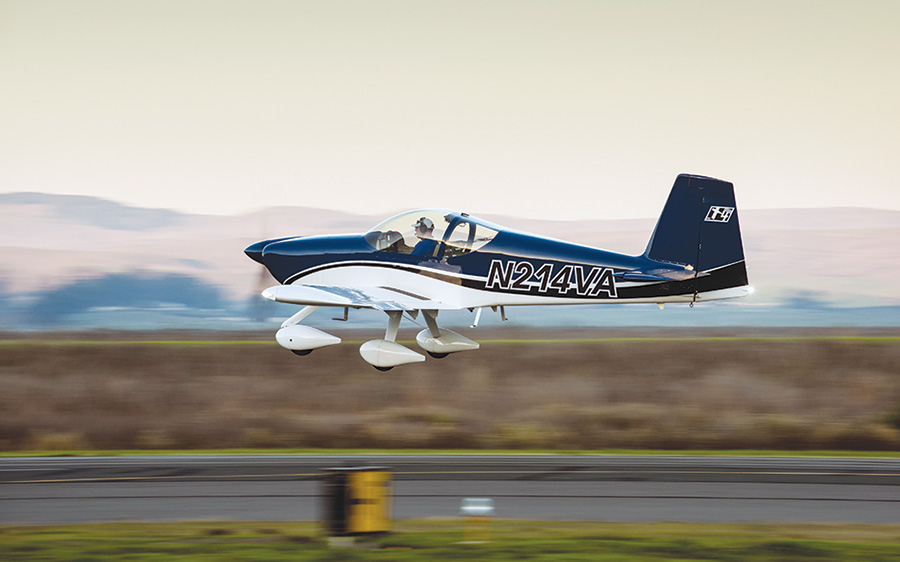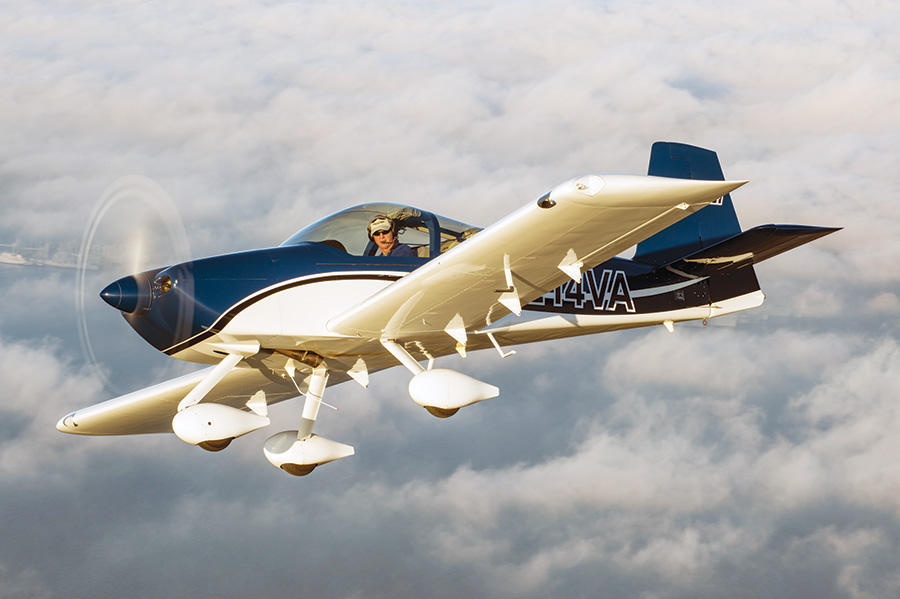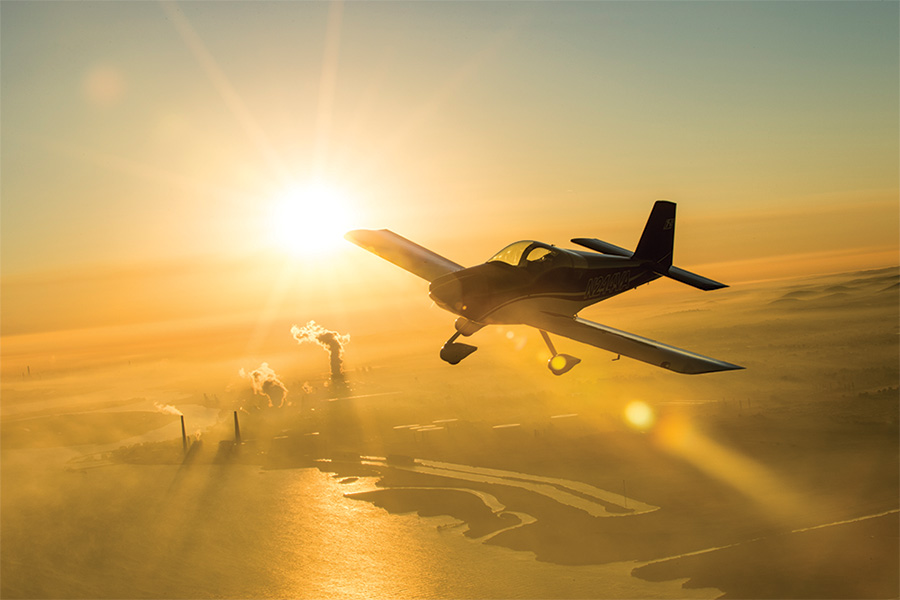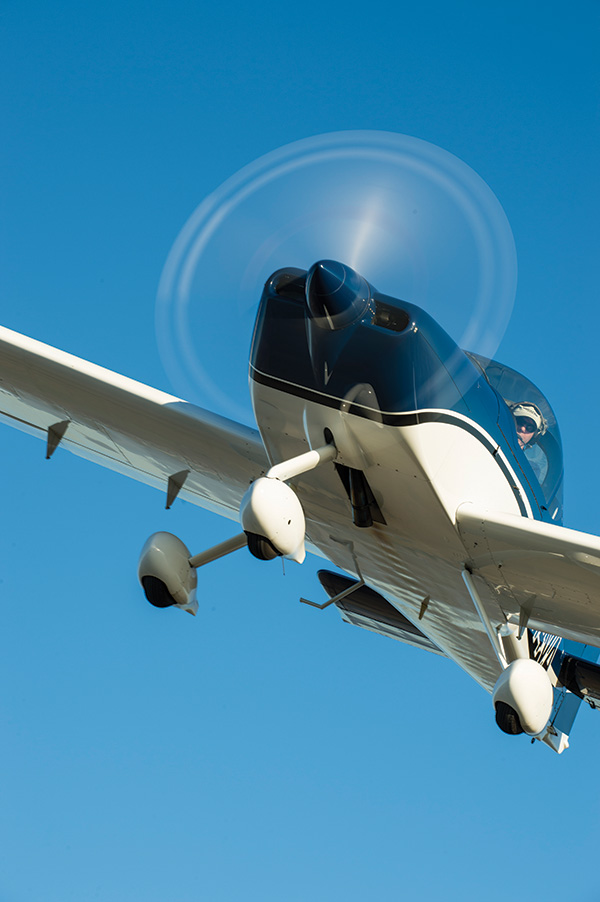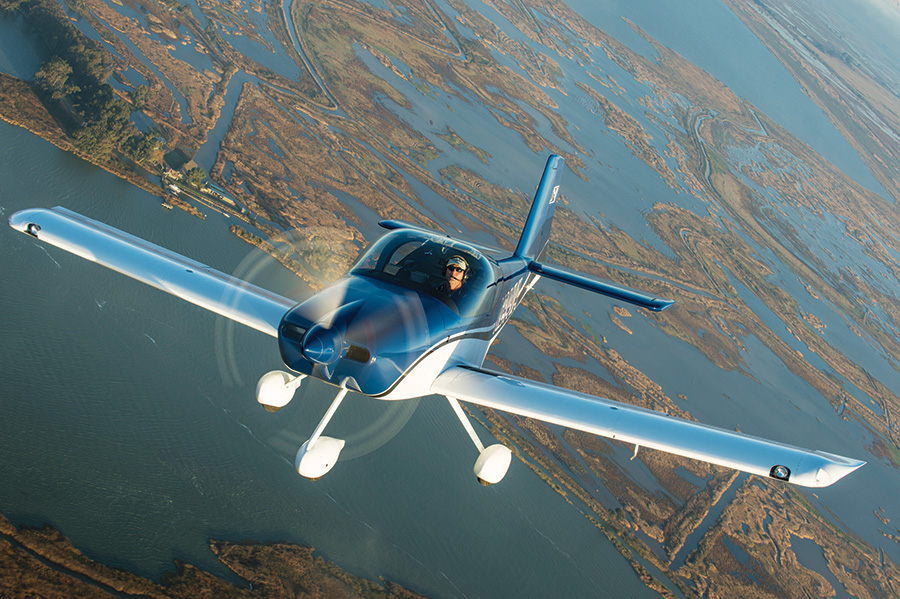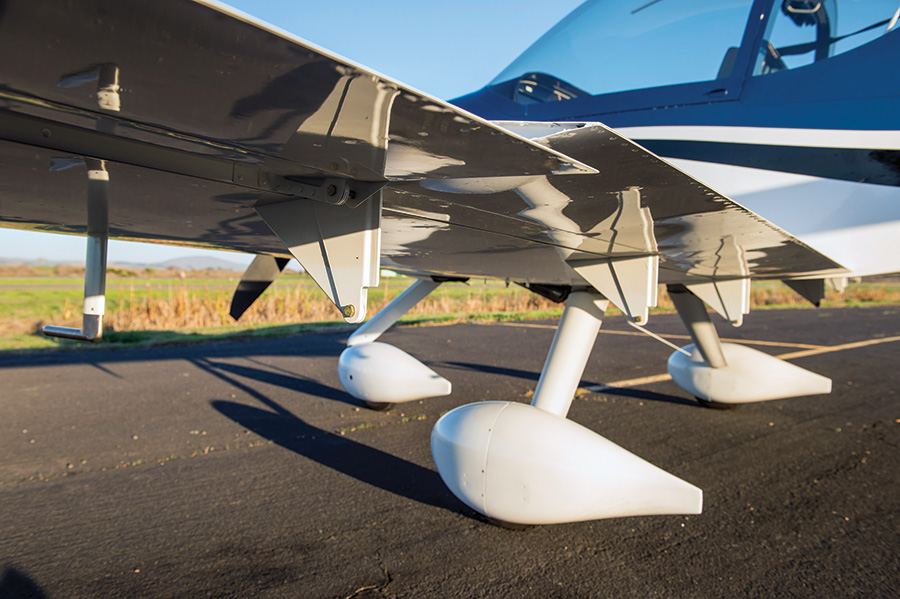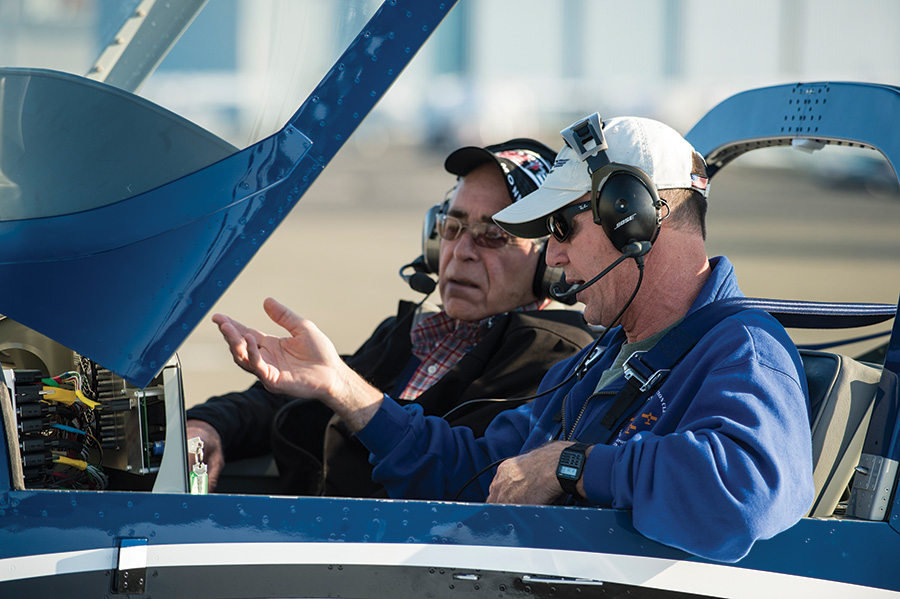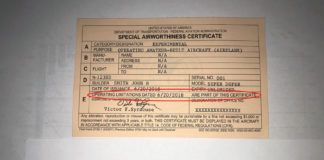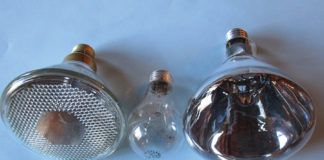When you’re the largest kit aircraft manufacturer in the world, it is not surprising that thousands of potential customers (many of them previous customers) spend a great deal of time trying to predict your next move. The advent of the Internet has made it possible for those thousands to trade ideas and speculation at light speed, across countries and even across continents. Soon the boundary between what people think a company might do next and what they would like the company to do next begins to blur, and the ideas can get pretty wild. So when it became known that the FAA had listed a new aircraft registration in the name of Van’s Aircraft called the RV-14, speculation reached a fever pitch. Would it be a high-wing bush plane? A competition aerobatic machine? Would the company finally produce a pre-punched, match-hole version of the single-seat RV-3? Or would it be the supersonic jet that a few had been lusting after?
Well, reactions varied when Van’s ended the speculation by debuting the airplane at AirVenture. Some were pleased, some disappointed, but all were curious about this new two-seater that somehow looked so familiar. Sitting tall and proud on tricycle gear, the RV-14 promised increased room and cargo capacity, sport aerobatic capability and a refined kit technology that incorporates everything Van’s has learned in four decades of kit building. On the surface, it appears to be a small step from what is already available in the company’s complete line of aircraft, and while this might have let down the casual observer, those who have looked more deeply into the design have found it both intriguing and exciting. While evolutionary in concept, it is revolutionary enough to deserve a close examination by those looking for a new two-seat aircraft project.
In the interest of full disclosure, I must confess a weakness for the RV line of aircraft. Our home hangar currently houses three different models, an RV-3, an RV-8 and one of the first RV-6s ever built. So it was with great interest that I accepted the assignment to review the RV-14 and compare it to what we already know. I caught up with the Van’s gang at their home facility in Aurora, Oregon, and got the chance to not only fly the airplane but discuss its genesis and genius with the design and production team behind the project, as well as with Van’s founder Dick VanGrunsven.
Why the RV-14?
The first question I put to Van was about the reasoning behind the RV-14. Why did he feel the world needed yet another two-seat RV kit, and what was the design process that led the team to the end result? The answer was that it is the next stage in an evolutionary process. The design was started as far back as 2005, at least that is the date on the first computer file labeled “RV-14.” At the time, the company was halfway through the design of the RV-12, its first Light Sport Aircraft contender. Two-seat kits for the RV-7 and RV-9 were flying out the door. The RV-10 kits were also being produced. Those who had flown the big four-seater liked its stable, cross-country properties, and the factory team began to consider what it would be like to have a similar two-seat design. Everyone knows that airplanes rarely fly with all of their seats filled, and while the RV-10 was perfect for many with significant load-carrying needs, others felt that they would like to have the same front-seat and baggage room without having to buy a six-cylinder engine and carry more airplane than they needed on every trip. The RV-14 was conceived to fill the desire for a larger, roomier two-seater while providing the capability for what is often referred to as “gentleman’s aerobatics,” the occasional roll or loop to satisfy the soul between cross-country trips.
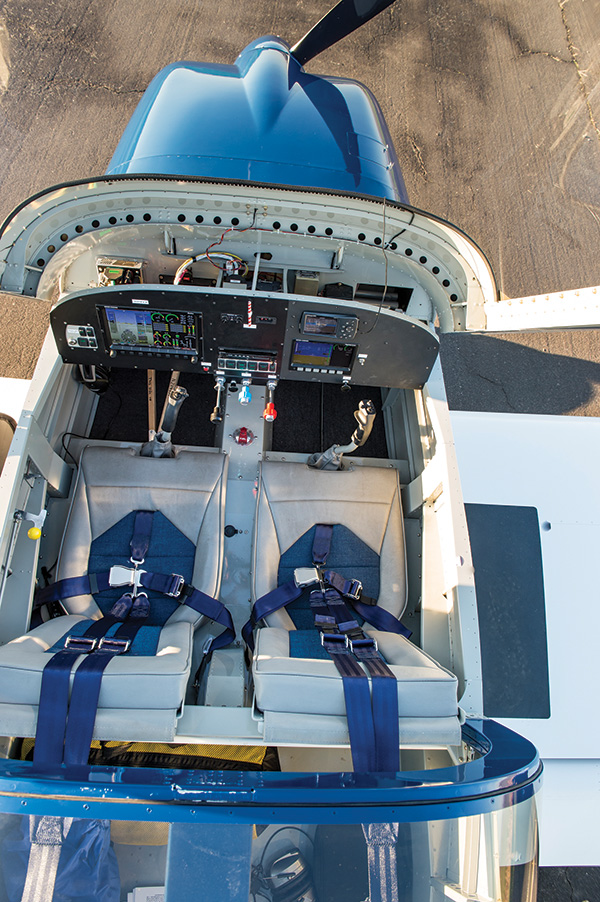
The cockpit of the RV-14 is indeed roomy, and the space behind the panel is very accessible with the canopy open.
The RV-14 was not intended to replace any of the current side-by-side two-seaters (the RV-7 or RV-9), in the same way that the RV-7 replaced the earlier RV-6. The RV-7 is really designed around the O-360 parallel-valve engines and is a somewhat compact design with sporty handling, whereas the RV-14 is a larger airplane with a wing optimized for cross-country sojourns, designed around the angle-valve IO-390 engine. Van sees the RV-14 in a slightly different class than the -7, and while potential buyers may consider both when looking for a two-seater, the differences in philosophy between the two designs will probably make them complementary rather than competitive.
One of the results of the RV-14 being larger is that it requires a bit larger powerplant than the RV-7. Right now, that means a 210-horsepower angle-valve IO-390, or potentially the older 200-hp IO-360 (with a commensurate decrease in performance). Many in the builder community have asked if it might be possible to build with the more-available parallel-valve 360s, and Van’s response is that the 40-pound-lighter engine would create a substantial weight-and-balance issue with the design. It is ironic that for most RV models, Van’s Aircraft is reminding builders not to add too much power to their airframes, but for the -14, the company is already cautioning folks not to put too little.
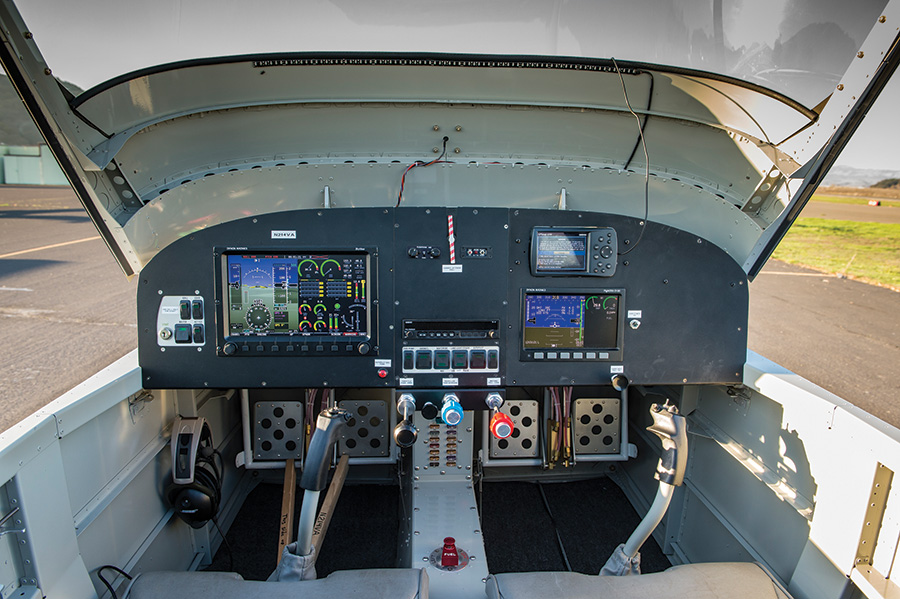
The prototype is nicely equipped with the Dynon SkyView system for flight and systems monitoring. There is plenty of panel space for those who want to build a complete IFR aircraft.
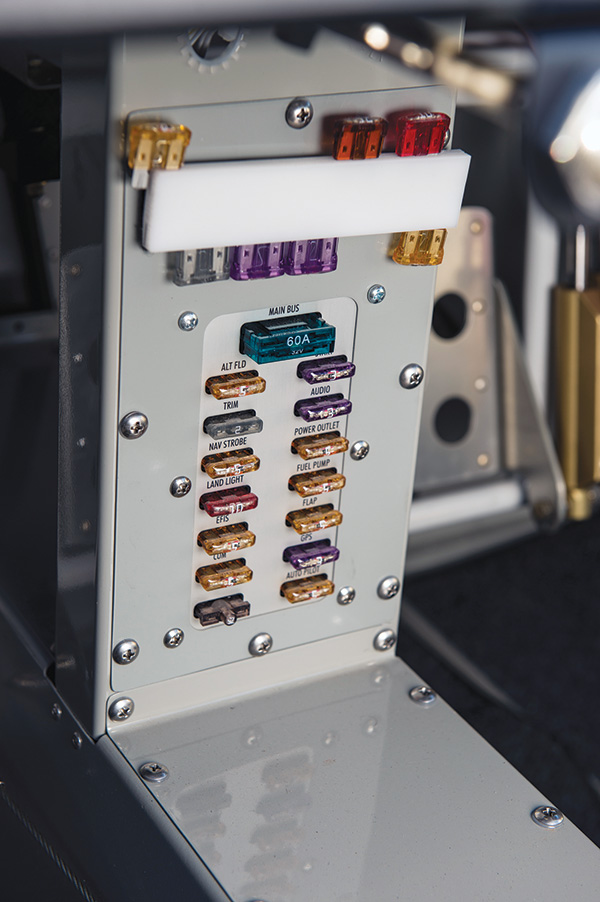
The fuse panel is easily accessible in flight, and spare fuses are conveniently supplied in a nylon block above the panel.
The RV-14 currently flying is actually an RV-14A. The “A” is used by Van’s to designate the trigear version of its designs. The fuselage is designed to support either tricycle or taildragger models (the taildragger will be the “straight” -14), and one of the initial beta builders will be assembling his with the little wheel in the back. The “A” model sits tall on the gear, and the boarding steps (one on each side) are consequently a bit high. Consideration is being given to lowering the maingear an inch to make it just a little easier to board, but no change comes without compromise, and that would change the attitude of the airplane on takeoff and landing. It will be interesting to see where the finished airplane comes out.
Airplane Features
The tip-up canopy incorporates some significant design changes from earlier two-place RVs. Not only is it larger (giving additional head and shoulder room), but it is significantly stiffer on the rear edge, flexing less in the wind while open on the ground. The most obvious change, however, is the lack of visible shock/hold-open struts. Their function has been incorporated into the hinge mechanism, so the entry/exit pathway for pilot and passenger is free and clear.
One other note about the design of the canopy is the lowered longerons, which provide easier entry and exit as well as bringing the canopy a bit lower relative to the occupants’ bodies. This has the result of providing better visibility and an even roomier cockpit—not quite as good as the RV-12, but superior to the rest of the side-by-side models.
Van’s has used several different nosewheel designs over the years, with the lessons learned from each design carefully folded into later versions. While all of the early two-seater “A” models use the same gear, the RV-10 and -12 use a different, improved design. The RV-14 follows this trend, and Van’s is still working to finalize what buyers will see in their kits. The design on the prototype was described as similar to the torsion-bar concept used in Grumman singles, but the redesign may be something closer to what is used in the RV-10.
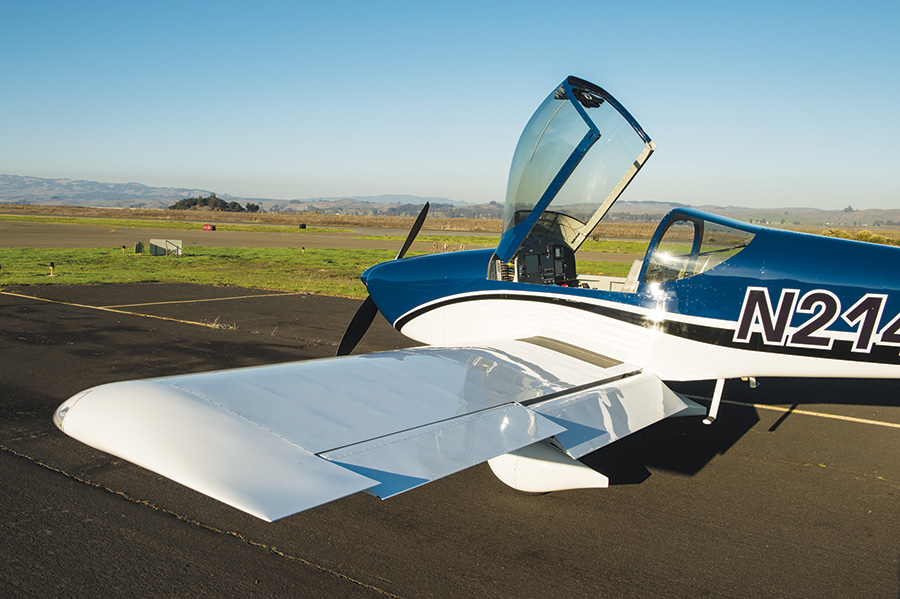
The RV-14 sits tall on the gear, but Van’s was considering shortening the maingear slightly on the next version.
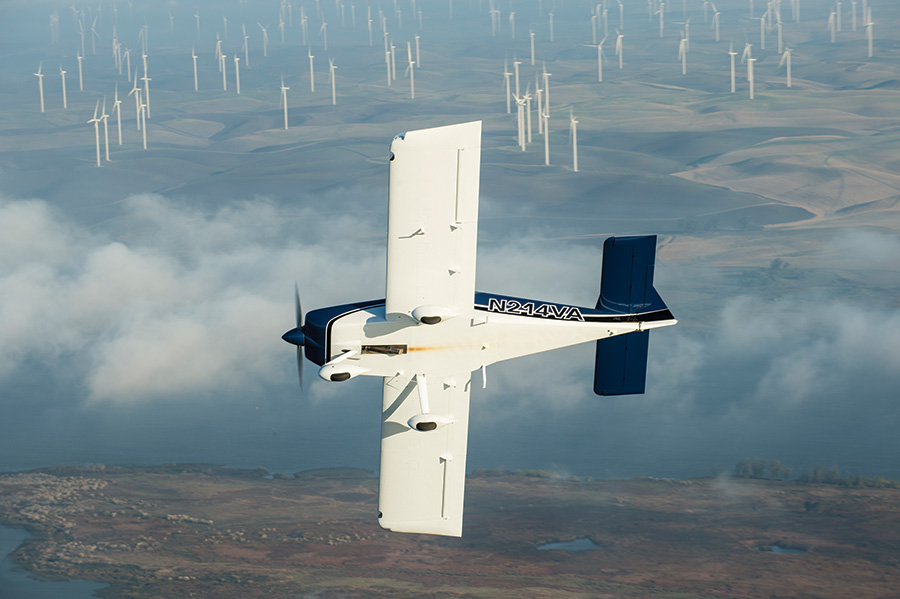
The current prototype is actually the RV-14A, the “A” designating the nosewheel version. The fuselage was designed for a conventional-gear version as well, and the prototype taildragger is under construction.
Flying It
The first time I climbed into the RV-14, I was surprised by how different it felt than the other two-seaters in the Van’s line. It was not just different; it was easier. This ease of entry comes largely from the longerons being considerably lower than on the other airplanes, along with the unimpeded opening presented by the tip-up canopy without shock struts. When Gus Funnel of Van’s technical support staff slid into the right seat, I realized how roomy the cockpit is: We were far from bumping elbows or shoulders at any time during the flight. I have spent considerable time in the earlier RV-6, and the difference here is remarkable. The seating position seems a little more laid back than the earlier designs, and the canopy is shaped to provide more volume, leading to an almost bubble-like experience for the pilot and passenger.
Seat adjustment is provided in the usual Van’s manner. The seat back has three different hinge lines on the floor and must be adjusted before flight to move the pilot closer to or farther from the pedals. This position can’t be changed in flight, but the legroom should be sufficient to let you find alternate positions to keep rigor mortis from setting in on long cross-country flights. Seat tilt can be adjusted by a hinged support that rests on the cross-cabin spreader, and builders can adjust the seating the way they want it with careful cushion choices.
The baggage area behind the two seats is not cavernous, but it is generous, as is the 100-pound weight allowance. Unless you are packing gold or lead ingots, it would be fairly difficult to exceed the weight limit in the volume allowed. Bags of clothing and even camping gear simply wouldn’t be dense enough to overload it.

The elevator on the RV-14 is fully balanced with external horns, a simple design typical of all of the two-place RVs.

Van’s has used a new nosewheel design for the RV-14 that will bear a resemblance to the one used on the RV-10. The prop is a Hartzell constant-speed unit.
Power Up
Engine start was normal for a fuel-injected powerplant, with all of the engine instruments depicted on the Dynon SkyView EFIS. The all-glass cockpit and well-labeled switches made system operations almost intuitive. The ignitions are controlled with two toggles, and we started on the left (only), using a key switch to control the starter. The right ignition was brought on after start, as was the alternator. Flaps are controlled with a toggle switch on the stick, and were a bit on the slow side; it took a good 10 seconds to raise them from the full down position (which is where most RV pilots park their flaps when on the ground). Funnel noted that the flap position is shown on the EFIS, and that there is a 3° reflex position used for cruise. He recommended that we take them out of reflex and use 0° for takeoff. Optionally, 10° of flaps can shorten takeoff if desired.
Taxiing was conventional for a nosewheel RV, with differential braking being the primary control at low speed. The airplane handled well, and it was easy to keep it right on the yellow line on the way to the runup area. The brakes are a good match for the size of the airframe, sufficient for control and stopping but not so overpowering as to induce tire-screeching results. The excellent visibility out of the cockpit in all directions (except straight aft) made me feel like I had no blind spots. The new nosewheel design inspired confidence, handling nicely, but habit in handling lightweight nosewheels over the years had me keeping the stick full aft to keep it lightly loaded.
The runup was purely conventional. We used a generic RV checklist, but detailed RV-14-specific checklists are in the works to accompany the standard configuration. We were ready to go in no time and lined up smoothly on the runway for departure. Standard Van’s takeoff technique for trigear airplanes is to start with the stick back to unweight the nosegear early in the roll, and I found this easier to do without “bobbing” the nose as on some of the smaller RVs (which can over-rotate until you get used to them). We lifted off almost as soon as full power was in, and we settled on a climb speed of about 110 knots, which gave better than 1600 fpm vertical velocity (with about half tanks), good cooling and excellent visibility ahead and to the sides.
In discussions with the engineering staff before the flight, I learned that the team is still working to tune the flight-control feel of the airplane. When I flew it, the aileron forces were considered to be a bit heavier than desired, and pitch forces a little light. Pitch forces had recently been adjusted to be a little heavier by changing the geometry of the elevator bellcrank, and testing is being conducted on various aileron trailing-edge shapes that might lighten the forces in roll. In the configuration flown, I was aware right off the bat that I was not flying a light, aerobatic RV. The -14 felt solid in roll, much like the RV-10, or a slightly heavier RV-9. Pitch forces were, predictably, somewhat lighter than I would have expected from a solid airplane, with a little null feeling in the neutral position. While neither issue was objectionable in its own right, it was obvious the configuration produced a less-than-harmonious feel, which is why the engineering staff is giving it considerable attention. During normal flight operations (climbs, turns and descents) this lack of harmony was not really a factor, but when we moved on to maneuvering flight (chandelles and lazy eights), it became more apparent.
Time to Climb
Climbing out from the Aurora State Airport, over the beautiful green fields of the Willamette Valley, the airplane’s field of view was a welcome feature. This will be an excellent touring machine, in every sense of the word, with pilots enjoying the wide-open scan for traffic, and passengers simply enjoying the view. In this regard, the airplane feels somewhat like a large, fast RV-12, which is also known for its good views from low canopy sills and a forward seating position. Once clear of the airport’s vicinity, I performed a few clearing turns, and concluded that the overall effect was almost as good as the bubble-canopied RVs I usually fly.
Normal and steep turns were simple and straightforward. Once trimmed for level cruise flight, turns at 30° and 60° of bank were easy to hold within 50 feet of altitude. It should be noted that the trim control speed is adjustable (on the ground) using a potentiometer on the control box behind the instrument panel. As was the case with the pitch and roll forces, the engineers are working to optimize the speed at which the trim motor runs. I found it to be too sensitive in cruise flight, with short blips of the coolie hat providing larger trimtab deflections than I needed. It took a little back-and-forth hunting to get the desired position, but once I found it, the airplane seemed to hold speed and altitude fairly well in the afternoon bumps. This is another area in which the airplane is being tweaked.
With the turns complete and the sky free of bogies, I pulled back the power and pitched the airplane to about 65 knots to see how it felt in slow flight. With the slower airflow, the aileron forces became much lighter, and the airplane was quicker to respond to roll inputs. Slow-flight turns were simple and solid. I eventually pulled back until the angle-of-attack system warned of the stall, and finally pulled to the stall itself, which was a non-event. The airplane simply put its nose down, pointed straight ahead and resumed flying. There was a nice little buffet along with the AOA warning. Similar results were obtained in a turning approach-to-landing stall. I repeated the exercise with the flaps down, and the break was a little more pronounced, but still slow and predictable.
After the Stalls
Cleaning up after the stall tests, we tried a few coordination maneuvers—a good way to sample the control harmony with the current control gearing. The airplane is aerobatic, so Funnel had no issues with simple commercial pilot maneuvers, so I pulled into a chandelle to the left. Sure enough, the light pitch and heavier roll forces made it a challenge to produce a smooth, flowing maneuver. Rudder forces, by the way, are typical RV, which means heavy at speed, lighter when slow, but essentially inconsequential because the airplane coordinates well on its own. Following the chandelle, I tried a lazy eight and again had to work fairly hard to keep it smooth all the way around. It is certainly possible, but not as easy as with the more mature RV designs. None of this will bother cross-country pilots who might spend more time with the autopilot engaged than without, but for those familiar with the outstanding harmony of the short-wing RVs, there may be something lacking. I look forward to seeing how Van’s improves this.
Mid-afternoon, with a sky full of cumulus, is a tough time to get reliable speed data, but I was curious to see how well the IO-390 would do at pulling an airplane this size. I set up 24 squared on the EFIS, engaged the Dynon autopilot and waited for things to settle out, which they finally did at a TAS of about 170 knots, an impressive number for an airplane that has yet to get upper and lower landing-gear intersection fairings (known in the RV world to be worth up to 12 knots of speed). This was a bit of an “eyeball average,” based on the Dynon’s calibration, but it met the spec sheet provided by the factory. Van’s is known for publishing realistic speeds for its kits, if they are built to plans, and the RV-14 will likely be as honest as the rest.
Aerobatics
Our air work would not have been complete in an aerobatic-capable aircraft without at least a quick aileron roll, so we climbed once again to a safe altitude to give it a try. Funnel said the technique would be the same as in my RV-8, just a little slower, so I started with a pull to about 20° nose up, relaxed back pressure and pushed the stick all the way to the right. The resulting roll was surprisingly smooth, with the nose drop (relative to the horizon) about what I expected. We finished about 5° nose low with little loss of speed. A similar roll to the left produced identical results, and I was satisfied. The airplane felt like a slightly heavier, slightly larger RV all the way around. While certainly not a threat to the IAC champions, those who want an occasional moment of unbridled upside-down joy won’t be disappointed. Frankly, doing aerobatics with the RV-10 wing seemed a little naughty, like wearing sneakers with a business suit, but since the engineers had given explicit permission, it was OK. I noticed that Funnel was smiling.
Landings
With maneuvering complete, it was time to return and try some landings. Once again, the RV-10-inspired wing made the task simple. As is my habit with RVs, I reduced pattern complexity by dropping all the flaps I intended to use at once, abeam the numbers. In this case, it was full flaps, as recommended by Funnel, along with an approach speed of about 75 knots. The airplane doesn’t come down like its short-wing brothers, but doesn’t soar quite like the RV-12. Altitude and energy management were natural; it was easy to come over the threshold with just a few feet to spare and skim the mains right on the numbers with a satisfying squeak. There was plenty of elevator authority to hold the nosewheel off the ground, and I probably could have kept it there through the ensuing “go” if the flaps were a bit quicker. However, since the airplane accelerates quickly, I was worried about getting too fast with the surfaces still in transit. So I let the airplane slow as I held the stick-mounted switch, then I added power back in for another complete takeoff and pattern exercise. The second landing was as smooth as the first (the sign of a good airplane is that it makes a rookie look good), and I could easily have made the first turnoff, which was about 700 feet down the runway. A third landing was just as easily accomplished, and we were done for the day, nosewheel current and smiling as we taxied back to the Van’s hangar.

The tail tie-down ring will be replaced with the tailwheel spring support structure in the conventional gear version. Its design will be familiar to any taildragger RV pilot.
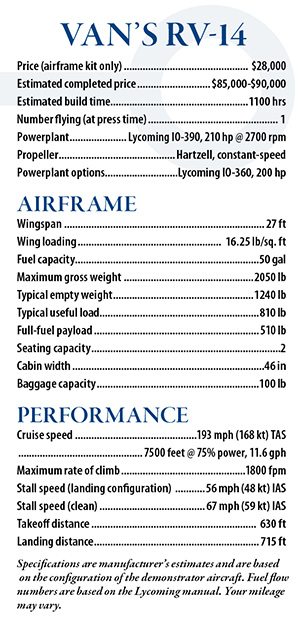
Overall, the RV-14 feels just like what it is: a larger two-place RV with solid controls and a pleasant response to bumps. It is extremely honest, with a benign stall that should keep pilots safe if they are paying attention. Control harmonies are an admitted work in progress, but the work is going well. Considering that the factory has yet to release fuselage or tail kits (only a couple of wing kits had been shipped to “beta builders” at the time of this review), there is plenty of time to work out those items to satisfaction. The new flat landing gear makes for nice touchdowns, and the all-new nosegear design should answer critics of the smaller trigears as to strength and behavior. This airplane is going to be exactly as advertised: a good cruiser with a little fun built in.
Final Impressions
When Van’s Aircraft introduces a new model, it is clear that a good deal of time, effort and thought have gone into the development of the project. The RV-14 demonstrates that careful approach, as did the RV-12 project before it, and the RV-10 before that. All three models have incorporated the match-hole construction pioneered by Van’s, and the building instructions for these models stand head and shoulders above anything else that Van’s has done. This should be an outstanding kit for new builders and an all-around excellent airplane for those requiring a little more room and carrying capacity. It remains to be seen how well the market responds to the need for the IO-390 engine to make the airplane perform as desired, but we can assume that with VanGrunsven’s experience and stature in the kit industry, the engines will be available to support the project at the best price possible.
The airplane is solid in flight and forgiving in the low-speed regime, and rolling it on a whim is a bonus you won’t find in many cross-country cruisers. Not everyone needs the aerobatic capability of the earlier models, and many who have bought the -9 and -10 did so because they valued cruise performance over that capability. Now they can have it all. The airplane has no bad habits, and as the factory tunes the prototype for more harmonious handling, it should appeal to those who appreciate a fine touring machine. I have said that the RV-10 feels like a European sedan, and the RV-14 approaches it in feel with significantly smaller mass, making it more responsive. Those experienced with the smaller RVs will note a less spirited airplane, while those upgrading from factory-built aircraft may be surprised at what they’ve been missing.
It is still early in the RV-14’s life, and time will tell how the market responds. But I believe it will find its niche among builders who want a roomy airplane that handles well, gives great cross-country performance and can carry enough for two people to live comfortably for a week or more “on the road.”
For more information, call 503/678-6545, or visit www.vansaircraft.com.
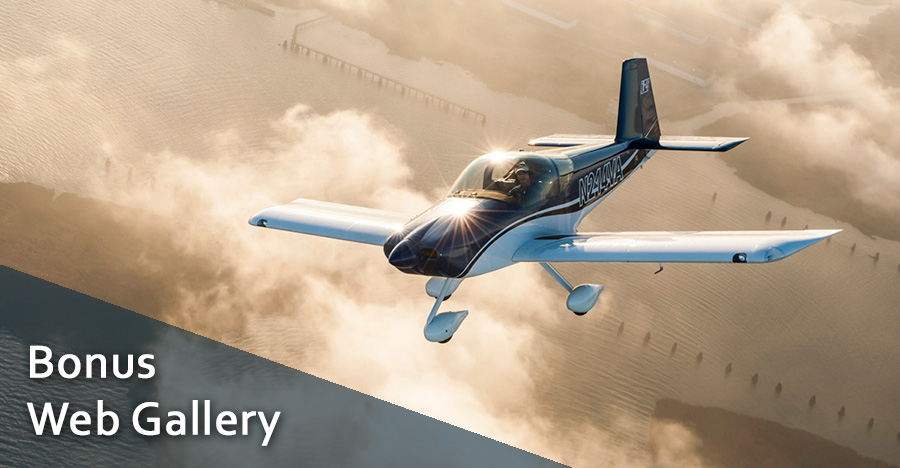
Sometimes we have more photos than we can fit in the print edition of Kitplanes, so starting with this issue, we’ll include those images in the online article. Click on the image above to see the Bonus Web Gallery.

